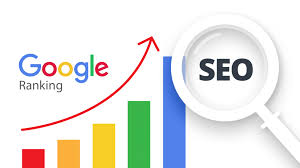How to Set Up SEO for Your New Website
-
November 11, 2025 3:26 AM PST
 Starting a new website is exciting, but to get people to actually find it, you need to set up SEO the right way from the beginning. Search Engine Optimisation (SEO) helps your website appear higher in Google search results, bringing in more visitors and potential customers. If you have just launched a new site, here’s a simple step-by-step guide to help you set up SEO and start getting organic traffic.
Starting a new website is exciting, but to get people to actually find it, you need to set up SEO the right way from the beginning. Search Engine Optimisation (SEO) helps your website appear higher in Google search results, bringing in more visitors and potential customers. If you have just launched a new site, here’s a simple step-by-step guide to help you set up SEO and start getting organic traffic.1. Start with Keyword Research
Before you do anything else, find out what your audience is searching for. Keyword research helps you understand the words and phrases people use to find information related to your business.
Use free tools like Google Keyword Planner, Ubersuggest, or Ahrefs Free Keyword Generator to find relevant keywords. Look for a mix of high-volume and low-competition keywords that match your products, services, or niche.
Once you have your keywords, plan how to include them naturally in your website content, titles, and meta descriptions.
2. Optimise Your Website Structure
A well-organised website helps both users and search engines. Make sure your site has a clean, easy-to-navigate structure.
Your URLs should be short, descriptive, and keyword-friendly. For example, use www.yourwebsite.com/seo-tips instead of www.yourwebsite.com/page?id=123.
Also, ensure your website loads quickly and looks good on all devices. Google values mobile-friendly, fast-loading websites.
3. Write High-Quality, SEO-Optimised Content
Content is the foundation of your website’s SEO. Create useful, original content that provides real value to your readers. Every page and blog post should focus on one main keyword while naturally including related terms.
Avoid stuffing keywords. Write for humans first and search engines second.
Use your target keyword in the following areas:
- Page title
- Meta description
- Headings (H1, H2, etc.)
- First paragraph of the content
- Image alt tags
4. Set Up On-Page SEO Elements
Each page on your site needs basic on-page optimisation. This includes:
- Meta Title and Description: Make sure each page has a unique title and description that includes your main keyword.
- Header Tags: Use proper headings (H1, H2, H3) to structure your content clearly.
- Internal Linking: Link to other pages on your website to help visitors find more content and help search engines crawl your site better.
- Image Optimisation: Compress your images to improve load speed and always use descriptive file names.
5. Install SEO Plugins or Tools
If your site runs on WordPress, install an SEO plugin like Yoast SEO or Rank Math. These tools make it easier to optimise your content, check keyword density, and create XML sitemaps.
For other platforms like Shopify, Wix, or Squarespace, check their built-in SEO settings. Most allow you to customise titles, meta descriptions, and alt tags easily.
6. Submit Your Site to Google Search Console
Once your website is live, please submit it to Google Search Console. This free tool helps Google index your website and lets you track performance, errors, and keyword rankings.
To do this:
- Go to Google Search Console.
- Add your website’s URL.
- Verify ownership using the suggested method.
- Submit your sitemap.
Google will start crawling your site and showing your pages in search results.
7. Build High-Quality Backlinks
Backlinks are one of the strongest ranking factors in SEO. They show Google that your website is trustworthy and relevant.
Start by sharing your website on social media, directories, and forums related to your niche. You can also write guest posts for other websites, collaborate with bloggers, or get listed on business directories to gain quality backlinks.
Here are the few backlink that you can replicate to get better position on Google:
- https://www.forum.newage.bg.kak-da.com/viewtopic.php?t=8593&sid=4dbeb2e8a5a174a948ca3405fdf8c967
- https://www.naaonline.org/itsyoung
- https://www.youyooz.com/profile/harveyalex12
- https://producerbox.com/users/Itsyoung
- https://www.checkli.com/rcdose044
- https://www.globaldemocracy.com/user/40632
- https://app.talkshoe.com/user/louishere
- https://hackmd.az.cba-japan.com/s/S1qNH_1kbl
- https://etherscan.io/public-profile?uid=5ee2a0f9
- https://enkling.com/read-blog/59731
- https://routinehub.co/user/louisyoung044
- https://newsocialbookmarkingsite.com/story/migrate-mbox-to-office-365-mailbox
- https://www.bandlab.com/user8974225954343175
- https://funddreamer.com/dashboard/?backer_profile=20962
- https://www.letsknowit.com/shoviv134491
- https://clearvoice.com/cv/LouisYoung
- https://app.wedonthavetime.org/profile/rajat_chauhan
- https://freeimage.host/imyoung
- https://tbbse.com/?post_type=listing&p=23392
- https://www.promoteproject.com/forum/topic/5422/migrate-google-workspace-to-microsoft-365-mailbox
- https://mymadhepura.com/listing/shoviv-g-suite-to-office-365-migration/
- https://sg-docs.gogox.com/discuss/69049da9bdd090fc24e61293
- https://organiqo.com/index.php/forum/thread/16997/migrating-from-google-drive-to-onedrive-here%E2%80%99s-what-you-need-to-know/
- https://myworldgo.com/forums/topic/253484/migrate-google-drive-to-one-drive-in-2025/view/post_id/2625055#siteforum_post_2625055
- https://www.blogvarient.com/profile/rajatchauhan
- https://shareshortcuts.com/u/louisyo044
- https://everydayblogs.com.au/profile/rajatchauhan
- https://www.pozible.com/profile/rajat-chauhan
- https://meta.decidim.org/profiles/louis_young/
- https://www.noteflight.com/profile/02a1f7d54d0c0def6281bd1134e3eb473d44affc
- https://hackmd.io/@sSRGXJvpROS1NJJf15eCjA/Sk7GKis6yl
- https://www.pozible.com/profile/rajat-chauhan
- https://hackmd.io/@sSRGXJvpROS1NJJf15eCjA/Hy2PYzIJ-g
- https://linkin.bio/shovivsoftware
- https://news.bangboxonline.com/migrate-google-drive-to-onedrive
- https://trueen.com/business/listing/shoviv-mbox-to-office-365-migration/655140
- https://www.investagrams.com/Profile/rajat3190393
- https://kadrmaskreations.com/forum/topic/how-to-migrate-email-from-google-workspace-to-microsoft-365/#postid-158880
- https://www.multichain.com/qa/user/rajatchauhan
- https://rotorbuilds.com/profile/178955
- https://adfreeposting.com/en/listing/shoviv-google-drive-to-onedrive-migration
- https://www.api.the-corporate.com/profile/Shoviv-G-Suite-to-Office-365-Migration
- https://uploadyourblogs.com/technology/migrate-google-workspace-to-microsoft-365-mailbox-in-2025
- https://aiplanet.com/profile/rajatchauhan
- https://confengine.com/user/louis-young https://www.portotheme.com/forums/users/rajatchauhan
- https://www.auclassifieds.com.au/shoviv-google-drive-to-onedrive-migration-i344133
- https://participez.nanterre.fr/profiles/louis_young/activity
- https://www.iglinks.io/louisyoung044-xgp?preview=true
- https://whotakescoin.com/listing///technical/shoviv-g-suite-to-office-365-migration
- https://onedio.co/profile/louisyoung044
- https://doc.chainsight.com/discuss/6911a3025035d89314bb1f5b
- https://campsite.bio/shovivtools
- https://velog.io/@rcdose044/
- https://direct.me/shovivtools#
- https://www.kittl.com/@rajatchauhan3
- http://globafeat-forum.149.s1.nabble.com/How-to-Migrate-Zimbra-Icewrap-Hotmail-G-suite-to-Office-365-td1193.html#a3795
- https://forums.planetdestiny.com/threads/how-to-migrate-google-drive-to-onedrive.35599/
- https://mapix.bizlisting.cloud/listing/shoviv-g-suite-to-office-365-migration/
8. Track Your Results and Keep Improving
SEO is not a one-time task. Use Google Analytics and Google Search Console to monitor your website’s performance. Check which pages are getting the most traffic, where your visitors come from, and what keywords are ranking.
Based on this data, keep updating your content, improving page speed, and fixing broken links to maintain strong SEO performance.
Final Thoughts
Setting up SEO for a new website may seem overwhelming at first, but once you understand the basics, it becomes much easier. Start with solid keyword research, focus on creating valuable content, and ensure your site is optimised for both users and search engines.
Remember, SEO takes time. Stay consistent, keep learning, and your website will gradually rise in Google search results.